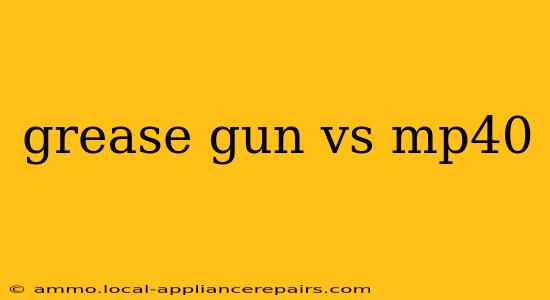The Second World War witnessed a proliferation of submachine guns, each with its own strengths and weaknesses. Two iconic examples, the American M3 "Grease Gun" and the German MP40, offer a fascinating case study in contrasting design philosophies and battlefield effectiveness. This article delves into a detailed comparison, examining their design, performance, and overall impact on the war.
Design and Manufacturing: A Tale of Two Approaches
The MP40, designed by Heinrich Vollmer, embodies a sleek, refined aesthetic. Its stamped steel construction, while initially intended to reduce manufacturing costs and time, resulted in a relatively lightweight and reliable weapon. The use of stamped steel, however, did make it slightly more susceptible to damage compared to weapons with more robust construction. The MP40's design prioritized ergonomics and ease of use, making it a popular weapon among German soldiers.
In contrast, the M3 Grease Gun, designed by George Hyde, prioritized speed and simplicity of manufacture above all else. Its design is markedly less elegant; its nickname, "Grease Gun," stems from its resemblance to a mechanic's grease gun. Constructed primarily from stamped sheet metal and featuring a telescoping bolt, it was incredibly cheap and fast to produce, meeting the urgent demands of wartime production. This prioritization of speed meant some compromises in terms of refinement and overall durability.
Performance and Reliability: On the Battlefield
The MP40 boasted superior accuracy and a smoother firing mechanism compared to the M3. Its 32-round box magazine, while slightly less capacious than some other submachine guns, offered a reliable feeding system. The MP40's overall build quality, despite the stamped steel, contributed to its dependable performance in various combat conditions.
The M3, while less accurate and possessing a harsher recoil, compensated with its significantly higher rate of fire. Its 30-round box magazine, while functional, sometimes suffered from feeding issues. Its simplicity and ease of maintenance, however, were highly advantageous in the field, particularly for less-trained troops. The high rate of fire, while potentially wasteful of ammunition, was effective in close-quarters combat and suppressing enemy fire.
Ammunition and Effectiveness: A Matter of Caliber
The MP40 utilized the 9x19mm Parabellum round, a powerful and widely used cartridge. This round offered a good balance of stopping power and range.
The M3 employed the .45 ACP round, known for its substantial stopping power at close ranges. However, its heavier bullet meant a shorter effective range compared to the 9mm Parabellum. The .45 ACP's superior stopping power was considered vital in close-quarters engagements where a quick, decisive incapacitation of the enemy was paramount.
Logistics and Production: Meeting Wartime Demands
The MP40's production, while efficient for its time, couldn't match the sheer volume produced by the US with the M3. The Grease Gun's simple design allowed for mass production, easily outpacing the MP40 in terms of numbers manufactured. This high production rate was a critical factor in supplying the vast Allied armies.
Conclusion: A Matter of Context
Determining a definitive "winner" between the MP40 and the M3 is impossible. Each weapon excelled in specific areas, reflecting the differing priorities of their respective nations. The MP40 represented a carefully engineered weapon prioritizing accuracy and reliability, while the M3 epitomized wartime expediency, sacrificing some refinement for sheer production volume. The context of their use – the battlefield conditions, tactical doctrines, and logistical considerations – ultimately dictated their effectiveness. Both weapons played significant roles in WWII, leaving their mark on military history.

